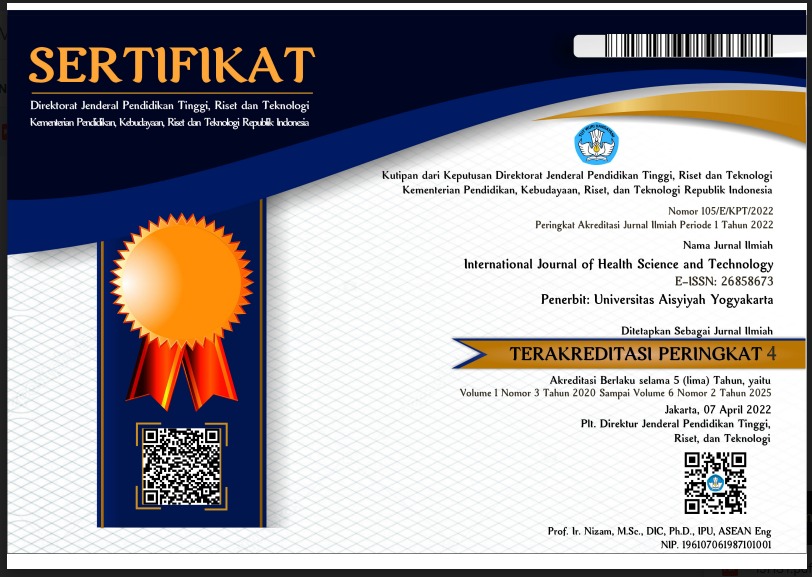Detection of Tilapia Lake Virus (TiLV) in Tilapia (Oreochromis niloticus) by Semi-Nested Reverse Transcriptase Polymerase Chain Reaction (RT-PCR) Method
DOI:
https://doi.org/10.31101/ijhst.v5i2.3316Keywords:
semi-nested reverse transcriptase polymerase chain reaction (RT-PCR); tilapia; Tilapia Lake Virus (TiLV)Abstract
References
Ariyanti, Yanti, and Sister Sianturi. 2019. “Ekstraksi DNA Total Dari Sumber Jaringan Hewan (Ikan Kerapu) Menggunakan Metode Kit for Animal Tissue.” Journal of Science and Applicative Technology 3(1): 40.
Bacharach, Eran et al. 2016. “Characterization of a Novel Orthomyxo-like Virus Causing Mass Die-Offs of Tilapia.” mBio 7(2).
Carr, Jeanne, Donna G. Williams, and Randall T. Hayden. 2009. “Molecular Detection of Multiple Respiratory Viruses.” Molecular Diagnostics: Techniques and Applications for the Clinical Laboratory (January): 289–300.
del-Pozo, J. et al. 2017. “Syncytial Hepatitis of Tilapia (Oreochromis niloticus L.) Is Associated With Orthomyxovirus-Like Virions in Hepatocytes.” Veterinary Pathology 54(1): 164–70.
Dong, H. T., S. Siriroob, et al. 2017. “Emergence of Tilapia Lake Virus in Thailand and an Alternative Semi-Nested RT-PCR for Detection.” Aquaculture 476(April): 111–18. http://dx.doi.org/10.1016/j.aquaculture.2017.04.019.
Dong, H. T., G. A. Ataguba, et al. 2017. “Evidence of TiLV Infection in Tilapia Hatcheries in Thailand from 2012 to 2017 Reveals Probable Global Spread of the Disease.” Aquaculture 479(April): 579–83. http://dx.doi.org/10.1016/j.aquaculture.2017.06.035.
Eyngor, Marina et al. 2014. “Identification of a Novel RNA Virus Lethal to Tilapia.” Journal of Clinical Microbiology 52(12): 4137–46.
FAO. 2022. FAO In Brief to The State of World Fisheries and Aquaculture 2022. Rome: FAO.
Hewajuli, Dyah Ayu, and NLPI Dharmayanti. 2014. “Perkembangan Teknologi Reverse Transcriptase-Polymerase Chain Reaction.” Indonesian Bulletin of Animal and Veterinary Sciences 24(1): 16–29.
Husna, Nadiatul, Hapsari Kenconojati, Mohammad Faizal Ulkhaq, and Arif Habib. 2020. “Pemeriksaan Tilapia Lake Virus ( TiLV ) Pada Komoditas Ikan Nila (Oreochromis niloticus).” Journal of Aqualculture Science 5(2): 77–87.
Mugimba, K. K. et al. 2018. “Detection of Tilapia Lake Virus (TiLV) Infection by PCR in Farmed and Wild Nile Tilapia (Oreochromis niloticus) from Lake Victoria.” Journal of Fish Diseases 41(8): 1181–89.
Muzuni, Didy Sopandie, Utut Widyastuti Suharsono, and Suharsono. 2014. “Isolasi Dan Pengklonan Fragmen CDNA Gen Penyandi H + -ATPase Membran Plasma Dari Melastoma Malabathricum L .” J. Agron. Indonesia 38(1): 67–74.
Ngaliyatun, Tuti Widianti, and Mukh Syaifudin. 2013. “Uji Daya Infektivitas Plasmodium Berghei Iradiasi Pada Hati, Limpa Mencit Menggunakan Nested-Pcr.” Unnes Journal of Life Science 2(2): 112–18.
Okanti, Jihan Rezi, Dwi Hilda Putri, and Ahmad Fathoni. 2020. “Analysis Of ZDS and LCYb Enzyme Coding Gene Related To Beta Carotene Bioshynthesis in Cassava (Manihot Esculenta Crantz) Using Reverse Transcription PCR (RT-PCR).” Bioscience 4(1): 01.
Ongagna-Yhombi, Serge Y. et al. 2013. “Improved Assay to Detect Plasmodium Falciparum Using an Uninterrupted, Semi-Nested PCR and Quantitative Lateral Flow Analysis.” Malaria Journal 12(1): 1–8.
Prayitno, Priskila Agnesia, Endang Srimurni Kusmintarsih, and Daniel Joko Wahyono. 2020. “Deteksi Molekuler Virus Dengue Serotipe 3 Pada Nyamuk Aedes aegypti Di Wilayah Purwokerto Timur.” BioEksakta : Jurnal Ilmiah Biologi Unsoed 2(2): 215.
Saragih, Maulana Sari, and Junaidi. 2021. “Deteksi Penyakit TiLV (Tilapia Lake Virus) Pada Ikan Nila (Oreochromis niloticus) Dengan Metode Rt-Pcr Di Balai Kipm Medan I.” Jurnal Perikanan 11(2): 6.
Surfianti, Oktarina, Soewarno, and Gunanti Mahasri. 2016. “Identifikasi KHV Dengan Uji Immunofluorescence Dan Immunocytochemistry Berdasarkan Uji Polymerase Chain Reaction Positif KHV Pada Ikan Koi (Cyprinus carpio).” Jurnal Biosains Pascasarjana 18(3): 267.
Taengphu, Suwimon et al. 2022. “Concentration and Quantification of Tilapia Tilapinevirus from Water Using a Simple Iron Flocculation Coupled with Probe-Based RT-QPCR.” PeerJ 10: 1–17.
Tsofack, Japhette Esther Kembou et al. 2017. “Detection of Tilapia Lake Virus in Clinical Samples by Culturing and Nested.” Journal of Clinical Microbiology 55(3): 759–67.
Downloads
Published
How to Cite
Issue
Section
Citation Check
License
Copyright (c) 2024 Arif Bimantara, Nosa Septiana Anindita, Taofani Rizal Al Amin, Wantonoro Wantonoro, Heni Setianah

This work is licensed under a Creative Commons Attribution-ShareAlike 4.0 International License.
International Journal of Health Science and Technology allows readers to read, download, copy, distribute, print, search, or link to its articles' full texts and allows readers to use them for any other lawful purpose. The journal allows the author(s) to hold the copyright without restrictions. Finally, the journal allows the author(s) to retain publishing rights without restrictions
- Authors are allowed to archive their submitted article in an open access repository
- Authors are allowed to archive the final published article in an open access repository with an acknowledgment of its initial publication in this journal

This work is licensed under a Creative Commons Attribution-ShareAlike 4.0 Generic License.










